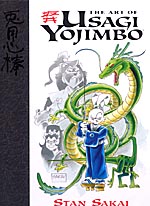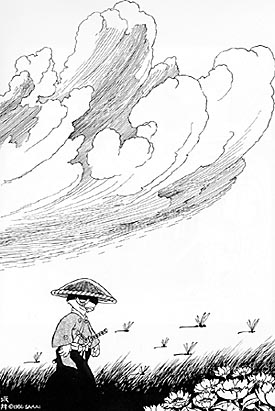 By Stan Sakai
By Stan Sakai
200 pages, black and white, with color pages
Published by Dark Horse
One of the best comics being published at the moment is Stan Sakai’s Usagi Yojimbo. Sakai’s stories of a ronin finding his way throughout the roads and paths of Japan are engrossing, and Sakai’s able to write his scripts pretty near-perfectly every month. With all of the attention paid to Sakai’s writing, though, it’s nice to see attention being paid to his art as well. That’s exactly what we get with The Art of Usagi Yojimbo, an oversized hardcover that looks at Sakai’s creation from an artistic standpoint. As enjoyable as Dark Horse’s earlier art books in this format were (The Art of Sin City, The Art of Hellboy, The Will Eisner Sketchbook), I have to say that I think this is my favorite one yet.
 The Art of Usagi Yojimbo opens with a section on the creative process, reprinting two short stories about the generation of ideas and how they become issues of the comic. The two selections here are pretty different from each other, but equally interesting. The first attacks the idea from a technical standpoint, talking about Sakai coming up with the genesis of an idea, researching in preparation for the script, and then visually creating the comic. It’s educational both in terms of a “how do they do that?” perspective and a “this is how much work is involved” lesson; Sakai’s attention to detail is spelled out here and will probably surprise many readers on just how much work goes into the book. The second story is more introspective, talking about Sakai’s artistic influences and the thought processes that go into the creation of a comic. It’s a much more personal piece, one that Sakai draws in raw pencil. The artistic choice makes sense; it’s about the genesis of a comic, so we’re getting an early, “unfinished” feel through his art.
The Art of Usagi Yojimbo opens with a section on the creative process, reprinting two short stories about the generation of ideas and how they become issues of the comic. The two selections here are pretty different from each other, but equally interesting. The first attacks the idea from a technical standpoint, talking about Sakai coming up with the genesis of an idea, researching in preparation for the script, and then visually creating the comic. It’s educational both in terms of a “how do they do that?” perspective and a “this is how much work is involved” lesson; Sakai’s attention to detail is spelled out here and will probably surprise many readers on just how much work goes into the book. The second story is more introspective, talking about Sakai’s artistic influences and the thought processes that go into the creation of a comic. It’s a much more personal piece, one that Sakai draws in raw pencil. The artistic choice makes sense; it’s about the genesis of a comic, so we’re getting an early, “unfinished” feel through his art.
 The section marked “Beginnings” starts Sakai’s survey of his career of drawing Usagi Yojimbo, looking at those early sketches and stories created about Usagi. Newer readers might be surprised to see a squatter version of Usagi, but the big double-take for me was seeing those first character designs where Usagi had rabbit buck-teeth protruding out of his mouth. It’s interesting to see the early tweaks and changes that Sakai made to the character unfold from one page to the next. As the book proceeds into “Early Years” it shifts more into reprinting already-published pieces, with Sakai picking a combination of character and artistic moments to reproduce. Looking at a page of Usagi walking with dragonflies overhead that eventually became a limited edition print, it’s easy to see why the beauty of Sakai’s art made him a natural subject for a book of this nature.
The section marked “Beginnings” starts Sakai’s survey of his career of drawing Usagi Yojimbo, looking at those early sketches and stories created about Usagi. Newer readers might be surprised to see a squatter version of Usagi, but the big double-take for me was seeing those first character designs where Usagi had rabbit buck-teeth protruding out of his mouth. It’s interesting to see the early tweaks and changes that Sakai made to the character unfold from one page to the next. As the book proceeds into “Early Years” it shifts more into reprinting already-published pieces, with Sakai picking a combination of character and artistic moments to reproduce. Looking at a page of Usagi walking with dragonflies overhead that eventually became a limited edition print, it’s easy to see why the beauty of Sakai’s art made him a natural subject for a book of this nature.
As the book eventually flows into “Middle Years” and “Recent Years”, as nice as they are one, the real treats remaining for me had to be the two color sections, “Painted Stories” and “Paintings & Color Art”. With Sakai’s comic published primarily in black and white (and Tom Luth handling the vast majority of coloring duties for the covers), it’s nice to be reminded that Sakai’s dabblings in color Usagi Yojimbo are also beautiful. His fully painted story “Return to Adachi Plain” is breathtaking, with watercolors helping give Usagi’s memories over the death of Lord Mifune a sort of tint over them, as if everything that happened that day has been forever covered with tears in Usagi’s mind. As much as I enjoy Sakai’s work in black and white (there’s a great part of his story about creation process where he shows the same panel inked with three different types of pens and it just reaffirmed what I already knew: Sakai is a fantastic artist who does everything deliberately), it’s nice to see his painted work (as well as a few collaborations with Luth) on display as well.

The Art of Usagi Yojimbo is a really handsome book, from the watermarked cover, to the semi-transparent colored papers used to mark off chapters (each with its own design), to the reproduction of the art within the book itself. Sakai and Cary Grazzini at Dark Horse have done a fantastic job of pulling this book together, and it’s a wonderful way to have celebrated Usagi Yojimbo‘s 20th anniversary. Here’s to twenty more years of gorgeous Sakai art in store.
Purchase Links:
